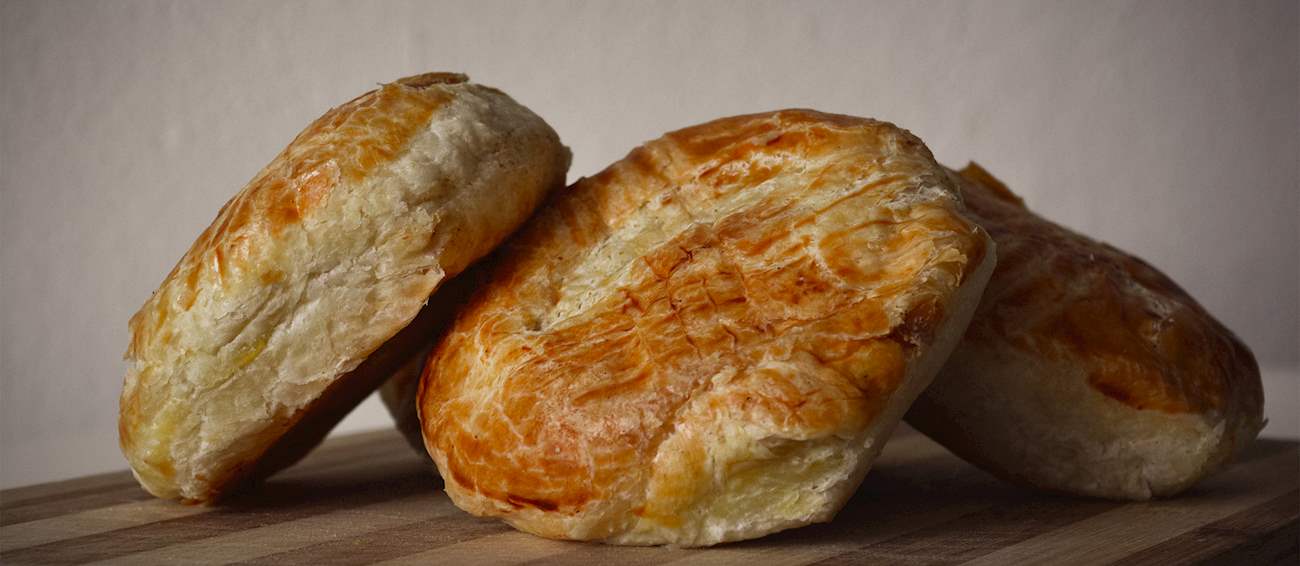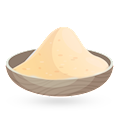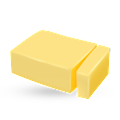MAIN INGREDIENTS
Hanım göbeği is a traditional sweet pastry originating from Turkey. It consists of choux pastry balls that are pressed in the middle to create a dimple, then deep-fried in hot oil and soaked in sugar syrup. The name of this sweet treat means lady's navel, hence the indentation in the middle of the pastry.
The dough is made with a combination of flour, sugar, eggs, butter, and salt, while the syrup is made with a mixture of sugar, water, and lemon juice. The dough should be fried in oil over medium heat, and the pastry is then placed into cold syrup.
MAIN INGREDIENTS
Boyoz is a Turkish pastry that was brought over to the country by Sephardic Jewish immigrants from Spain in the late 15th century. Nowadays, it is prepared exclusively in Izmir, following the original recipe. The pastry is made with flour, sunflower oil, and tahini.
Tahini increases the nutrient value of boyoz, but it also makes the dough rise in layers. Boyoz is additionally filled with ingredients such as cheese, meat, olives, artichokes, or spinach. Traditionally, this flavorful pastry is served as an essential part of breakfast, when it is accompanied by hard-boiled eggs sprinkled with black pepper and a glass of Turkish tea.
MAIN INGREDIENTS
Kandil simidi is a variety of Turkish simit pastry. It is traditionally prepared and consumed only during the Kandil religious holiday. The dough is made with butter, oil, yogurt, eggs, flour, baking powder, sugar, and salt. Once it has been shaped into rings, the dough is coated in sesame seeds, then baked until golden brown.
Over the course of five holy nights, kandil simidi is baked in many Turkish households and bakeries, and it is traditionally offered to friends and relatives.
MAIN INGREDIENTS
Dilber dudağı is a traditional dessert consisting of layered phyllo pastry filled with nuts and soaked in honey. It's prepared with a combination of milk, hazelnuts and walnuts, eggs, butter, oil, lemon juice, flour, sugar, and baking powder. The dough is usually shaped into half-moons, then cooked until golden brown and drizzled with sugar syrup or honey.
The name of the dish means a beautiful woman's lips, referring to its unique shape and visual appearance.
MAIN INGREDIENTS
Sour cherry baklava is a popular Turkish dish – its refreshing and light fruit filling delivers just enough tartness to serve as a nice contrast to this sugar-laden dessert. Though the sourness of cherries goes hand in hand with the lemon-flavored syrup, vişneli baklava is also often enjoyed with a dollop of kaymak, Turkish clotted cream.
A lighter variation on the classic baklava, sütlü nuriye is made with a hazelnut filling and doused in a milk-based syrup. The origins of this baklava are somewhat vague—while the word sütlü translates to milky, Nuriye is a Turkish female name—so the only known thing is that the dessert had been created during the 1980s.
Back then, due to a major supply shortage, Turkish baklava makers thought of using milk to make a lighter syrup with half the amount of sugar, and the expensive pistachios used in classic baklava were replaced by hazelnuts.
MAIN INGREDIENTS
Nokul is a flavorful Turkish pastry that is visually reminiscent of a cinnamon roll. However, nokul consists of flour, salt, sugar, yeast, vegetable oil, and a flavorful poppy seed filling that is dispersed throughout the swirls. The pastry is baked until golden-brown in color, and it is then served hot, sometimes even as an appetizer instead of bread.
MAIN INGREDIENTS
Turkish tulumba is a hot water dough fritter traditionally found in the cuisines of the former Ottoman Empire, particularly throughout the Middle East and the Balkans. Even though tulumba (lit. pump) was named after a special tool used to make it—a kind of syringe with a star-shaped nozzle—in Iranian cuisine they call it bamiyeh; in Egypt and Syria balah el-sham, and datli in Iraq; while in the rest of the Arab world tulumba fritters are also known as asabe Zainab (lit. Zainab's fingers).
These deep-fried, crisp-shelled treats deliver a serious kick of sugar as they are soaked in thick, sometimes lemon-flavored syrup. In Lebanon and Syria, they often use orange blossom and rose water for flavoring, while Gulf countries add cardamom and saffron as well, and in Morocco they use heated honey instead of syrup.
MAIN INGREDIENTS
Called rurki or rurki z kremem in Poland, this sweet specialty is a type of cream roll consisting of thin pastry that’s typically filled with whipped cream or pastry cream. It is often dubbed torpedo dessert due to its characteristic shape, and apart from Poland, there’s also a long-standing tradition of preparing this dessert in other countries.
The origins of rurki are often associated with Türkiye and Bulgaria, where the dessert is known as torpil tatlısı and funiiki s krem, respectively. There are many variations of this sweet delicacy regarding the ingredients used for its preparation, the appearance, texture, and flavor of the rolls, and the type of cream used for filling the pastry.
Açma is a type of Turkish pastry characterized by its soft and flaky texture. The soft dough is traditionally twisted and rolled up into a bagel, which can be made in a sweet or savory version. It consists of flour, sugar, salt, yeast, yogurt, milk, eggs, butter, and olive oil.
This pastry can be easily found in most Turkish bakeries, where it is often sprinkled with sesame seeds.
TasteAtlas food rankings are based on the ratings of the TasteAtlas audience, with a series of mechanisms that recognize real users and that ignore bot, nationalist or local patriotic ratings, and give additional value to the ratings of users that the system recognizes as knowledgeable. For the “11 Worst Rated Turkish Pastries” list until April 19, 2025, 7,652 ratings were recorded, of which 4,019 were recognized by the system as legitimate. TasteAtlas Rankings should not be seen as the final global conclusion about food. Their purpose is to promote excellent local foods, instill pride in traditional dishes, and arouse curiosity about dishes you haven’t tried.











